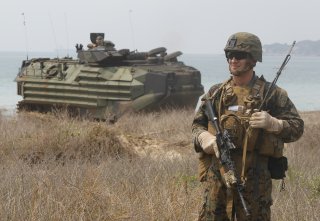The U.S. Marine Corps’ Amphibious Combat Vehicle Has a Few Problems
A recent report sheds some light on the U.S. Marine Corps’ newest vehicle. It’s not great.
The United States is transitioning from long, grinding land campaigns that defined the conflicts in the Middle East during the last two decades to counter an increasingly belligerent China. Perhaps no other service branch is undergoing as much institutional change during this time period as the Marine Corps.
The Marine Corps is accommodating the shift by introducing a wide array of new equipment, including the M27 rifle, shedding many armor platforms, and introducing a new ship-to-shore 8x8: the Amphibious Assault Vehicle (AAV).
Amphibious Combat Vehicle
The Amphibious Combat Vehicle (ACV) replaces the Marine Corps’ Cold War-era Assault Amphibious Vehicle. The AAV has been in service for nearly half a century and is old in the tooth. Following a deadly accident off the California coast last year that killed nine sailors and Marines, the Marine Corps moved to ban amphibious AAV operations indefinitely.
The Marine Corps would like to acquire four ACV variants: a personnel squad maneuver variant that can carry a total of thirteen Marines and three crew members (presumably a driver, gunner, and commander) complete with two day’s worth of supplies and combat equipment; a command-and-control variant for ACV commanders; a recovery and maintenance variant; and a 30-millimeter gun variant that can offer Marines fire support.
Though the ACV is an improvement over the older AAV, a recent report from the Congressional Research Service on the Amphibious Combat Vehicle outlines some of the ACV’s shortcomings.
ACV Troubles
The report explains that “while the ACV demonstrated good operational availability and maintainability during IOT&E, it did not meet its 69-hour mean time between operational mission failures (MTBOMF) threshold.”
Two pieces of equipment were the sources for the most significant number of failures, the “government-furnished Remote Weapons System (RWS)—an internally controlled, exterior-mounted MK 19 automatic grenade launcher or M2 .50 caliber heavy machine gun.”
Additionally, thanks to the size and placement of the ACV’s blast-mitigating seats, interior space is cramped, making ingress and egress awkward and slow. Also, the Marines noticed that the seats were not contoured to the shape of body armor and were uncomfortable.
During evaluation exercises, Marines noted that while the ACV is highly mobile, the vehicles were not equipped with a tire jack, making the ACVs reliant on recovery vehicles for tire changes and significantly slowing down operations.
Though the ACV is undoubtedly an improvement on the legacy AAVs, several kinks are still to be worked out. Still, the platform holds promise for an increasingly capable—and aquatic—U.S. Marine Corps.
Caleb Larson is a multimedia journalist and defense writer with the National Interest. A graduate of UCLA, he also holds a Master of Public Policy and lives in Berlin. He covers the intersection of conflict, security, and technology, focusing on American foreign policy, European security, and German society for both print and radio. Follow him on Twitter @calebmlarson
Image: Reuters

